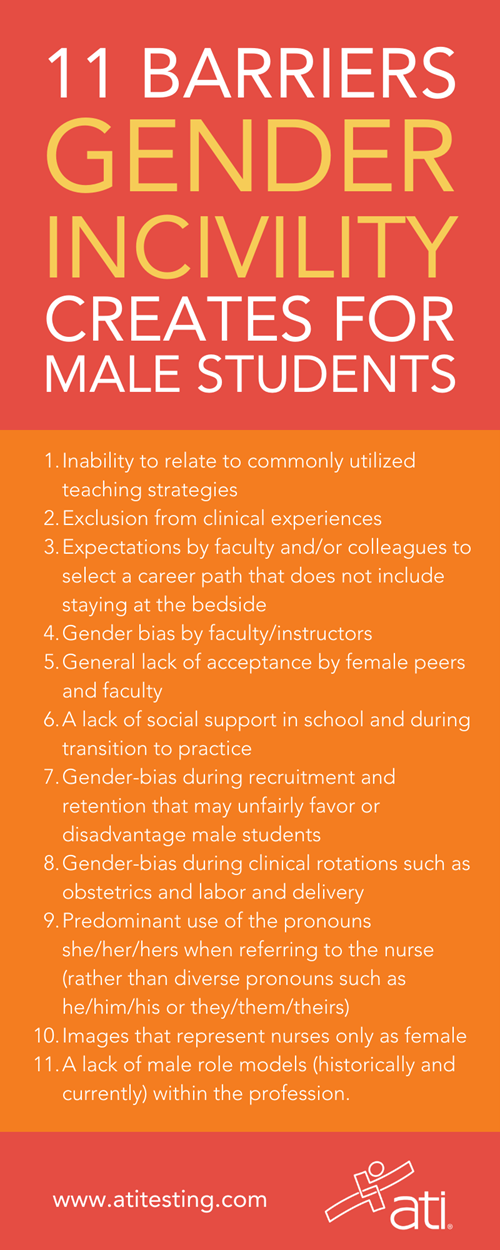IT’S TIME TO OVERCOME THE INSIDIOUS MALE BIAS IN NURSING
HOW EASILY GENDER-ASSOCIATED INCIVILITY HAPPENS IN NURSING SCHOOLS: PART I
INTRODUCTION:
 Incivility remains a significant issue globally in nursing education and healthcare. By definition, incivility manifests itself as being rude or disrespectful, which can create emotional turmoil and even physical distress. Another type of incivility is gender bias. A call to action and heightened awareness of this area for nursing faculty, students, and healthcare professionals is paramount. Additionally, recognition of gender bias and gender minority are key responsibilities for everyone to be aware of for fostering and maintaining an equitable environment.
Incivility remains a significant issue globally in nursing education and healthcare. By definition, incivility manifests itself as being rude or disrespectful, which can create emotional turmoil and even physical distress. Another type of incivility is gender bias. A call to action and heightened awareness of this area for nursing faculty, students, and healthcare professionals is paramount. Additionally, recognition of gender bias and gender minority are key responsibilities for everyone to be aware of for fostering and maintaining an equitable environment.
The following article on this subject is well-defined and explored by our colleagues from Duke University and the American Association of Nurse Anesthesiology. These experts focus a valuable optic lens on this much-needed change for healthcare. — Janet McMahon, DNP, MSN, RN, ANEF, Manager, Curriculum & Integration, NCLEX Services, ATI Nursing Education
BY
BENJAMIN SMALLHEER, PHD, RN, ACNP-BC, FNP-BC, CCRN, CNE
STEPHANIE GEDZYK-NIEMAN, DNP, MSN, RNC-MNN
MARGORY MOLLOY, DNP, RN, CNE, CHSE
BRETT MORGAN, DNP, CRNA, FAAN
 In the United States, most students enrolled in entry-level baccalaureate nursing programs identify as female. This does not accurately mirror the demographics of the general population and has been slow to change over time when compared to other professions where a gender disproportion historically exists (such as medicine and education).
In the United States, most students enrolled in entry-level baccalaureate nursing programs identify as female. This does not accurately mirror the demographics of the general population and has been slow to change over time when compared to other professions where a gender disproportion historically exists (such as medicine and education).
When a gender-disproportion exists, there is a higher likelihood of incivility occurring.5,6,8,13 Therefore, men — because of their minority gender status — are at a greater risk of experiencing gender-associated uncivil behaviors during their educational program.
Academic incivility — whether initiated or experienced by faculty, students, or administrators — is a considerable challenge for nursing education. The effects of these behaviors can be significant by disrupting the learning and work environments where faculty teach and students learn. If left unaddressed, these offenses may escalate and progress into more serious or threatening situations, thus potentially damaging the academic environment.4
GENDER-ASSOCIATED INCIVILITY IN NURSING EDUCATION
Incivility is defined as a range of rude, disrespectful, or aggressive behaviors that may result in emotional or physical distress for all those involved.3 Incivility also comprises a variety of other behaviors such as:
- failing to act or speak up when action is warranted
- withholding vital information
- marginalizing and excluding others.
More overt acts of incivility include:
- spreading rumors and negative gossip
- posting disparaging comments on digital or social media sites
- making demeaning or belittling remarks towards others.
DOWNLOAD THE INFOGRAPHIC AT RIGHT AS A HANDY REFERENCE
Male students have reported experiencing the following barriers during their nursing education:
- inability to relate to commonly utilized teaching strategies
- exclusion from clinical experiences
- expectations by faculty and/or colleagues to select a career path that does not include staying at the bedside
- gender bias by faculty/instructors
- general lack of acceptance by female peers and faculty1,7,9,16
- a lack of social support in school and during transition to practice
- gender-bias during recruitment and retention that may unfairly favor or disadvantage male students
- gender-bias during clinical rotations such as obstetrics and labor and delivery2
- predominant use of the pronouns she/her/hers when referring to the nurse (rather than diverse pronouns such as he/him/his or they/them/theirs)
- images that represent nurses only as female12
- a lack of male role models (historically and currently) within the profession.2,9,11,14,15
A CALL TO ACTION FOR NURSING FACULTY
Faculty members play a key role in creating and maintaining an equitable and respectful environment conducive to learning, as well as role-modeling civility. If not addressed in the educational setting, students can continue these uncivil behaviors into nursing practice. Students who are of the gender-minority rely on faculty to intervene when they experience gender-associated incivility;10 therefore, nursing faculty must be able to identify gender-associated uncivil behaviors.
Part II of this article series will explore strategies that nursing educators can use to prevent gender-associated incivility, as well as interventions that educators can use if it does occur.
---------------------------------------------------------------------
Authors: Benjamin Smallheer, PHD, RN, ACNP-BC, FNP-BC, CCRN, CNE; Stephanie Gedzyk-Nieman, DNP, MSN, RNC-MNN; Margory Molloy, DNP, RN, CNE, CHSE; and Brett Morgan, DNP, CRNA, FAAN, wrote a paper on the topic of gender incivility for Nursing Forum journal. You can read it — “Faculty development workshop on gender-associated incivility in nursing education” — in the October 2021 issue to learn more. Their paper was also the topic of a session — “Call to action: Strategies to address gender-associated incivility in nursing education” — at the October 2021 National Nurse Educator Summit.

Dr. Smallheer is an associate professor at Duke University School of Nursing. He leads the Adult-Gerontology Acute Care Nurse Practitioner program and is an active clinician. His area of research and scholarship include advancing the learning experience for students in nursing education through the use of technology and innovative teaching strategies.
 Dr. Gedzyk-Nieman is an assistant professor at Duke University School of Nursing. She leads the maternal and child health content for the Accelerated Bachelor of Science in Nursing program. Her area of scholarship is improving the learning experience for gender-minority students.
Dr. Gedzyk-Nieman is an assistant professor at Duke University School of Nursing. She leads the maternal and child health content for the Accelerated Bachelor of Science in Nursing program. Her area of scholarship is improving the learning experience for gender-minority students.
 Dr. Molloy is an associate professor at Duke University School of Nursing and the Assistant Director of the Center for Interprofessional Education and Care Center. Her area of scholarly work includes training of simulation facilitators in nursing education to impact both student learning experiences and patient care.
Dr. Molloy is an associate professor at Duke University School of Nursing and the Assistant Director of the Center for Interprofessional Education and Care Center. Her area of scholarly work includes training of simulation facilitators in nursing education to impact both student learning experiences and patient care.
 Dr. Morgan is the Senior Director for Education and Practice at the American Association of Nurse Anesthesiology. He is the former Nurse Anesthesia-DNP program director at Duke University School of Nursing. His work focuses on improving access to safe surgery through nurse-driven models of anesthesia care. In addition, he continues to work on multispecialty approaches to decreasing incivility in the perioperative environment.
Dr. Morgan is the Senior Director for Education and Practice at the American Association of Nurse Anesthesiology. He is the former Nurse Anesthesia-DNP program director at Duke University School of Nursing. His work focuses on improving access to safe surgery through nurse-driven models of anesthesia care. In addition, he continues to work on multispecialty approaches to decreasing incivility in the perioperative environment.
The team has disseminated its work on gender-incivility at both national and international conferences.
Dr. Gedzyk-Nieman is presenting a session on “Inclusion of LGBTQ+ healthcare into nursing education” at the upcoming National Nurse Educator Summit, April 10-13, in Seattle. Dr. Molloy will present on “Using trigger films to confront racism and bias in health profession education” at the same event.
REFERENCES
1. Carnevale, T., & Priode, K. (2018). "The Good Ole' Girls' Nursing Club": The Male Student Perspective. Journal of transcultural nursing: official journal of the Transcultural Nursing Society, 29(3), 285–291. https://doi.org/10.1177/1043659617703163
2. Carrigan, T.M., & Brooks, B.A. (2016). Q: How will we achieve 20% by 2020? A: Men in nursing. Nurse Leader, 14(2), 115-119. https://doi.org/10.1016/j.mnl.2015.12.012
3. Clark, C. M., & Ritter, K. (2018). Policy to Foster Civility and Support a Healthy Academic Work Environment. The Journal of nursing education, 57(6), 325–331. https://doi.org/10.3928/01484834-20180522-02
4. Eka, N., & Chambers, D. (2019). Incivility in nursing education: A systematic literature review. Nurse education in practice, 39, 45–54. https://doi.org/10.1016/j.nepr.2019.06.004
5. Gedzyk-Nieman, S. A., & Svoboda, G. (2019). Exploring attitudes of acceptance of males in nursing among registered nurses. Journal of nursing management, 27(3), 647–654. https://doi.org/10.1111/jonm.12723
6. Heikes J.E. (1991). When men are the minority: the case of men in nursing. The Sociological Quarterly, 32(3), 389‐401. DOI: 10.1111/j.1533-8525.1991.tb00165.x
7. Hodges, E. A., Rowsey, P. J., Gray, T. F., Kneipp, S. M., Giscombe, C. W., Foster, B. B., Alexander, G. R., & Kowlowitz, V. (2017). Bridging the Gender Divide: Facilitating the Educational Path for Men in Nursing. The Journal of nursing education, 56(5), 295–299. https://doi.org/10.3928/01484834-20170421-08
8. Kanter, R.M. (1977). Some effects of proportions on group life: Skewed sex ratios and responses to token women. American Journal of Sociology, 82(5), 965-990. https://doi.org/10.1086/226425
9. Kim, K.A., Won, M.H, Shin, S.H., Go, G.Y., & Choi, J. (2016). Male nursing students' practicum experiences on delivery room. Journal of the Korean Academia‐Industrial Cooperation Society, 17(2), 458‐469. https://doi.org/10.5762/KAIS.2016.17.2.458
10. Kirkpatrick, D., & Kirkpatrick, J. (2006). Evaluating Training Programs. 3rd ed. San Francisco, CA: Berrett‐Koehler Publishers.
11. Morgan, B., Smallheer, B., Molloy, M., & Gordon, H. (2018, July 19-23). Identifying strategies for addressing perceived barriers to education for pre-licensure male nursing students [Podium presentation]. 29th International Nursing Research Congress: Innovative Global Nursing Practice and Education Through Research and Evidence-based Practice, Melbourne, Australia. https://sigma.nursingrepository.org/handle/10755/624161
12. Powers, K., Herron, E. K., Sheeler, C., & Sain, A. (2018). The Lived Experience of Being a Male Nursing Student: Implications for Student Retention and Success. Journal of professional nursing : official journal of the American Association of Colleges of Nursing, 34(6), 475–482. https://doi.org/10.1016/j.profnurs.2018.04.002
13. Smallheer, B., Gedzyk-Nieman, S. A., Molloy, M. A., Clark, C. M., Gordon, H., & Morgan, B. (2021). Faculty development workshop on gender-associated incivility in nursing education. Nursing forum, 56(4), 1044–1051. https://doi.org/10.1111/nuf.12615
14. Smallheer, B., Morgan, B., & Stern, R. (2020). A historical look at men's involvement in nursing and leadership in GAPNA. Geriatric nursing (New York, N.Y.), 41(1), 52–53. https://doi.org/10.1016/j.gerinurse.2020.01.003
15. Stott A. (2007). Exploring factors affecting attrition of male students from an undergraduate nursing course: a qualitative study. Nurse education today, 27(4), 325–332. https://doi.org/10.1016/j.nedt.2006.05.013
16. Younas, A., Sundus, A., Zeb, H., & Sommer, J. (2019). A Mixed Methods Review of Male Nursing Students' Challenges during Nursing Education and Strategies to Tackle these Challenges. Journal of professional nursing: official journal of the American Association of Colleges of Nursing, 35(4), 260–276. https://doi.org/10.1016/j.profnurs.2019.01.008
HAVE YOU EXPERIENCED GENDER INCIVILITY? SHARE IN THE COMMENTS BELOW TO HELP OTHERS FACING THIS ISSUE.
